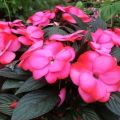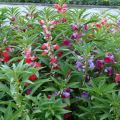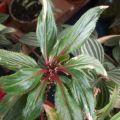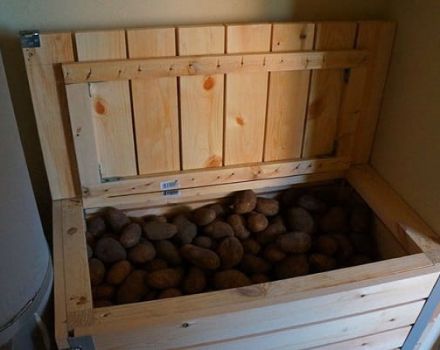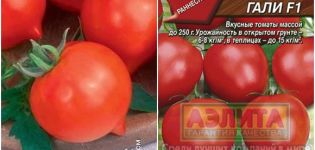Planting, growing and caring for a flower Vanka Wet at home
Since olden times, the Vanka Wet flower has been grown as a houseplant, and its care is very simple. It needs to be watered regularly and fed from time to time. New hybrids have been bred, in which large double flowers, abundant foliage, and the stem itself does not stretch upwards, but forms a spherical bush. The plant is called balsam and can be planted in a flower bed and in a flower pot.
Content
- 1 Description and characteristics
- 2 Kinds
- 3 Popular varieties of balsam
- 4 Growing from seeds at home
- 5 Conditions for growing a flower in the garden
- 6 Features of indoor growing in a pot
- 7 Popular species and varieties
- 8 Planting and care in the open field
- 9 Reproduction
- 10 Seedling growing
- 11 Care features
- 12 Diseases and pests
- 13 Flower arrangements
- 14 Reviews
Description and characteristics
Vanka Wet belongs to the Balsamin family, which consists of two genera - Hydrocera and Balsamin (or Impatiens). The genus Hydrocera has only one species of the same name, whose representatives live in swamps. The genus Impatiens is numerous, it includes 500 species of plants. Some of them are used in floriculture.
Plants from the Balsam family live all over the earth. Most Impatiens prefer the humid tropics of Africa and Indochina. In the temperate continental climate of Russia, you can find 8 varieties, among them - Forest balsam, which has long been used as a medicine.
A whole group called Waller's (Waller) balsam is cultivated as an indoor flower. These are perennials with lush, but compact, highly branched bushes, 15-40 centimeters high, with shiny, greenish or cherry-bronze leaves and scarlet, purple, snow-white, pinkish or variegated flowers.
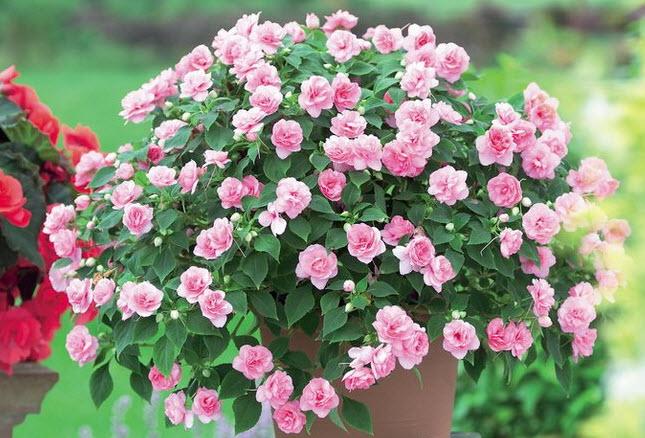
There are flowers single or collected in inflorescences, simple or double, in shape - pink, camellia, carnation. Touch-me-not looks like a lush bouquet with flowers growing at the top. It blooms for a long time, from April to December. After pollination in the fall, seeds ripen in a small, but very sensitive to touch, capsule.
In addition to indoor balsam, garden balsam is grown, which is called - Impatient Balsamic.
Sadovy is an annual culture with a pyramidal or highly branched, almost spherical, stem, 40-70 centimeters high. Blooms profusely throughout the summer (May to October). The stems are juicy, as if saturated with moisture, translucent. Leaves are petiolate, small, lanceolate, pointed upwards, arranged in the next order. Flowers - large, irregular, can have all sorts of colors - from pale pink to deep burgundy.

In Russia, balsam was nicknamed Vanka Wet for a reason. The plant loves water. It does not tolerate drought at all. In case of a lack of moisture, it instantly withers, the leaves wrinkle, the flowers droop.
Balsam is called Wet also for the reason that a sugary liquid appears at the edges of the leaves of the plant. This protective property of balsam protects flowers from attacks by ants and aphids. The pollen and flower nectar remain for the bees, which also pollinate the flowers.
Monastic Sugar is another name that the plant got thanks to sweet dew drops. Impatiens often release a sugary liquid after abundant watering. Bright red flowers resemble lights. The people called the balsam Fire. In European countries, the plant is called Diligent (Diligent) Lisa, as it blooms tirelessly from April to November.
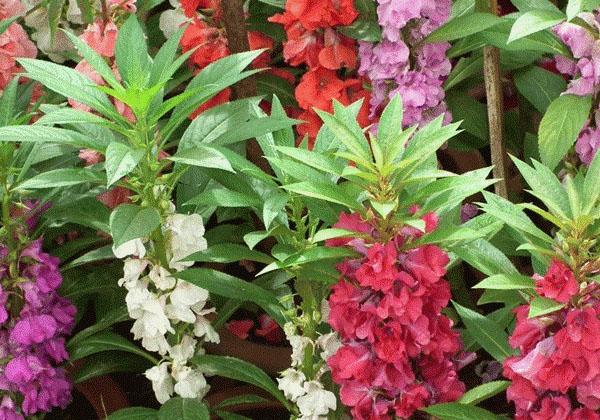
The touchy balsam was named for the method of spreading seeds. When a ripe fruit is touched, it opens with a bang, the shutters quickly twist into spirals, and the seeds fly up to 2 meters. Vanka Mokroi has very brittle shoots. This is one of the plant propagation methods. Broken off cuttings can be put into water, and later planted.
Kinds
There are over 500 types of balsams. Plants vary in height, color and flower shape. Indoor and garden balsams are divided into 3 groups.
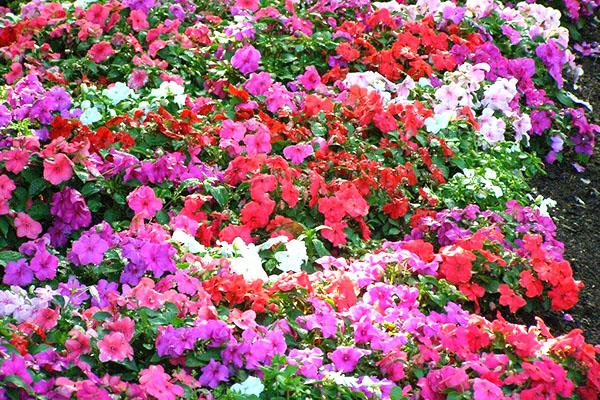
Touchy groups:
- First.
This group includes the traditional varieties of Waller's balsam. They are grown in pots, greenhouses, or garden beds. This species is represented by various varieties and interesting hybrids. Flowers are simple or double, snow-white, pinkish, purple, reddish.
- Second.
This group includes heterotic hybrids (F1). They appeared as a result of breeding work with the Impatient Waller. Hybrid varieties are represented by perennial compact bushes that bloom profusely for almost a whole year.
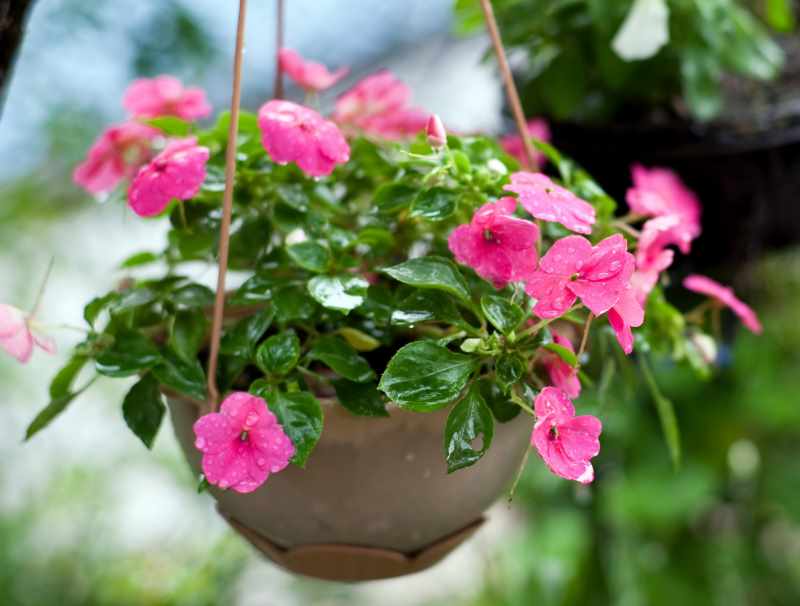
- Third.
This group includes balsams from New Guinea. New Guinea hybrids were obtained from crossing of balsam Hawker, linear-leaved, Schleiger. These plants can be found in the forests of New Guinea. New Guinea hybrids have fleshy leaves, a strong stem, large flowers, a more compact appearance. They are mainly used in indoor floriculture.
To size
Balsams can have different stem heights. It is customary to plant low-growing hybrids in indoor pots, and with the help of tall plants they usually decorate city flower beds and garden plots.
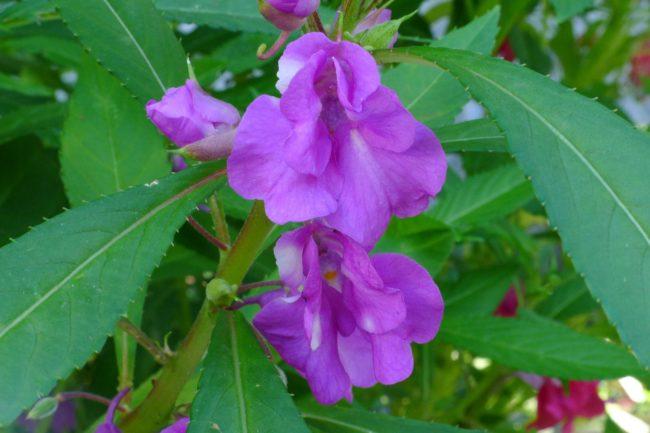
Dwarf
This group includes balsams up to 26 centimeters high. Small dwarf bushes of perennial plants are grown in indoor pots. They differ in color and flower shape. These include various varieties of Balzamin Waller. Low-growing annuals are often planted in garden plots and city flower beds.
Medium-sized
Medium-sized plants include plants reaching 26 to 41 centimeters in height. These are compact branched bushes with green leaves and flowers of various colors and shapes. This group includes garden balsam, New Guinea hybrids.
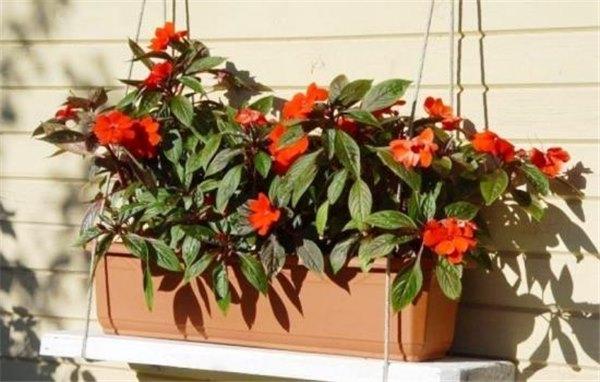
Tall
Impatiens, whose height is 75 centimeters and above, belong to the tall group. Most often, these plants are planted as a hedge or border flower. The plant has a pyramidal or spherical shape. The stems are juicy, fleshy, the leaves are lanceolate, growing in the next order.The plant is abundantly decorated with large flowers of various shades of red.
By form
The main advantage of balsams is flowers. One plant can have up to 50 of them. According to their doubleness, the flowers are divided into camellia-like, pink-like and clove-like.
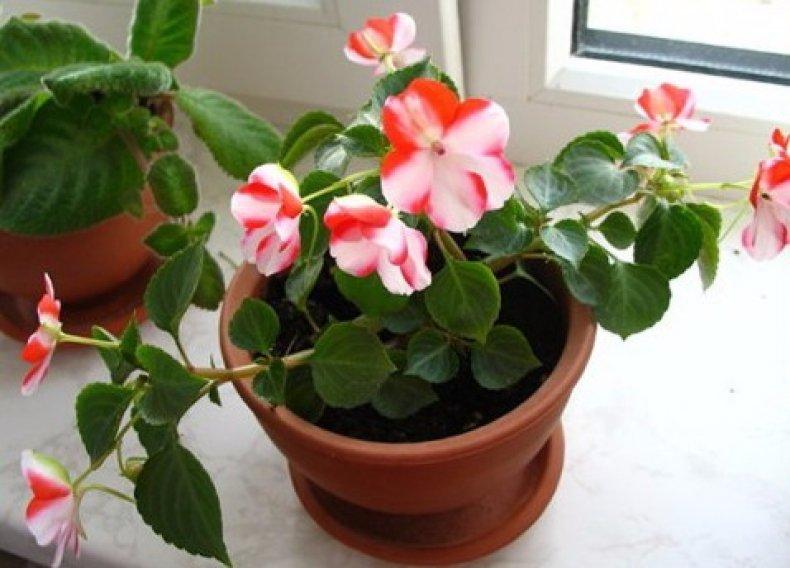
Camelliaceae
Large double flowers look like camellia. There are pale pink, reddish, white, lilac shades.
Carnation
The flowers are reminiscent of a Dutch double carnation. The petals have fringed or serrated edges. They can be pale pink, reddish, lilac or variegated.
Rosy
Densely double flowers resemble tiny roses. The petals are wrapped in a spiral. Flowers can be monochromatic or bicolor.
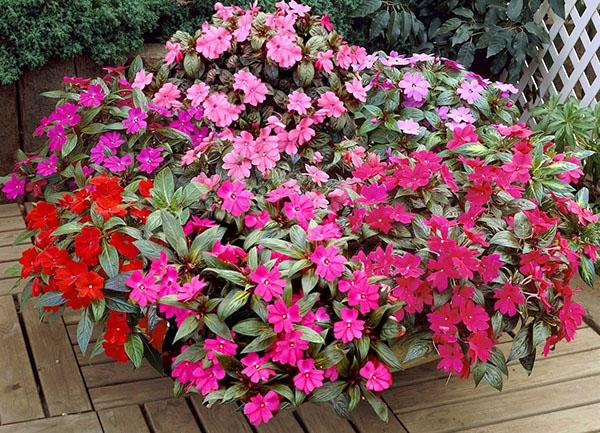
Popular varieties of balsam
Many varieties of Nedotrog are bred on the basis of Waller's balsam, garden or New Guinea. They differ in color, size and shape of flowers, as well as the height of the bush.
Garden Tom Tamb
This short balsam bush (25 centimeters) is planted in city flower beds and garden plots. The plant has oblong lanceolate leaves, double flowers of various shades (pink, scarlet, lilac, snow-white). Tom Tamb is a one-year-old blooming all summer long.
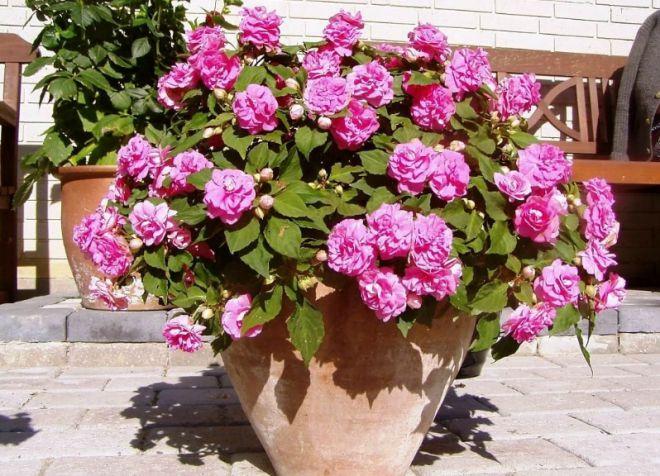
Camellia
Tall and highly branching plant. It can stretch up to 61 centimeters in height. The Camellia variety blooms for a long time and abundantly. Flowers are double, pale pink or purple. An annual used for flower bed decoration.
Waller
Waller touch-up is a popular indoor and garden culture. Height - 26-40 centimeters. The bush has a spherical shape, juicy, highly branching stems. Flowers can be simple and double, of various colors. Impatiens blooms for almost 90 days. The variety is often used to breed new hybrids.
Exotic dwarf
A small plant often used to decorate balconies. Impatiens are only 20 centimeters tall. Leaves are lanceolate, serrate. Flowers can be purple, pink, bright red.
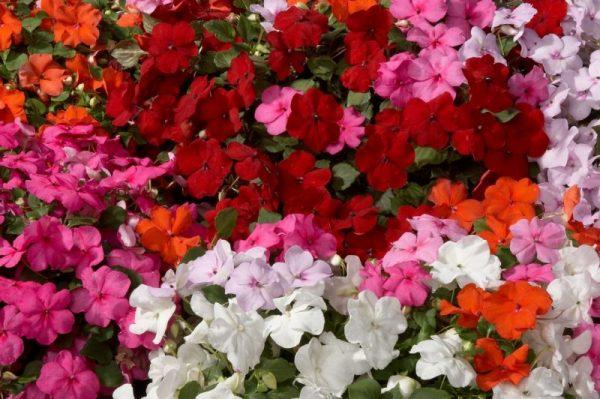
Harmony
A beautiful, compact plant derived from New Guinea Balsam. Forms a lush bush, strewn with large round flowers on top. This thermophilic plant is usually grown in indoor pots.
Java
Long blooming Impatiens, bred on the basis of New Guinea balsam. This plant has bright, exotic-looking flowers blooming against the background of shiny greenish or bronze leaves.
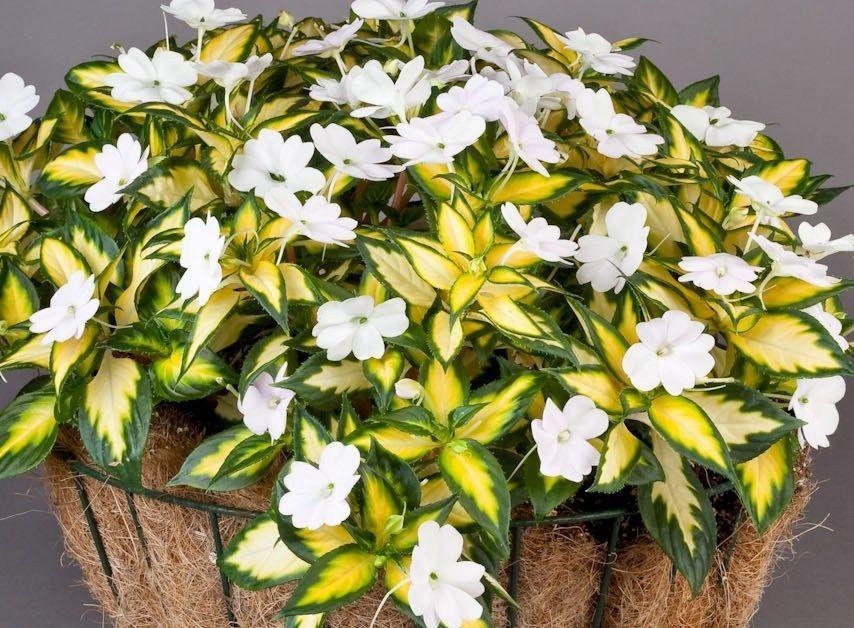
Mini jini
A series related to New Guinea hybrids. The balsam has small dark green leaves and numerous small flowers that cover the bush almost all year round.
Macarena
Balsam from the group of New Guinea hybrids. Impatiens have bright, luminescent, orange flowers and bronze-green leaves.
Camelia flowered
Tall plant. The variety is bred on the basis of garden balsam. It has a high pyramidal stem, oblong leaves, pink or lilac flowers.
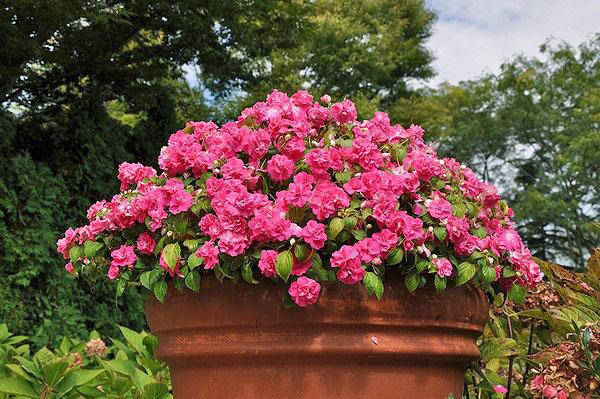
Peppermmint
Erect pyramidal plant, 40-45 centimeters high. Flowers - camellia-like, large, double, can be scarlet, pink, solid or white speckled. The annual blooms in gardens from June to September.
Baby bush (Baby bush)
Low-growing garden plant. One year old, reaching 25 centimeters in height. Blooms for a long time with large pink-like flowers.
Tom thumb
Dwarf garden variety. One-year-old blooming all summer. Flowers - terry, can have snow-white, pink, scarlet, lilac color.
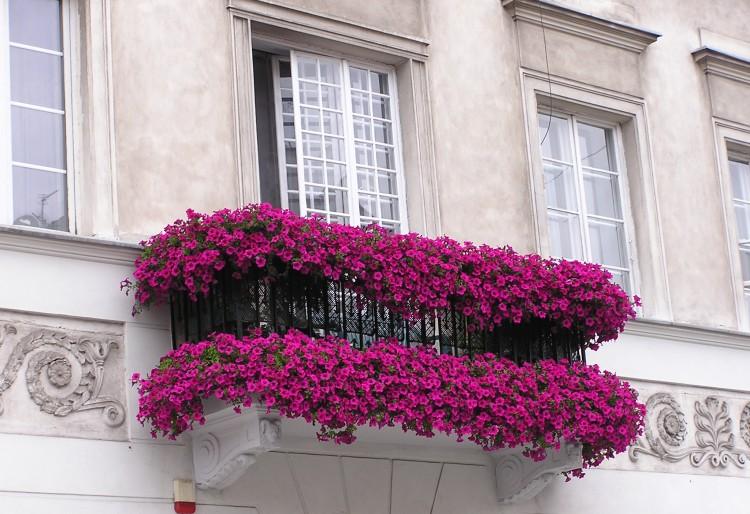
Scarlett
Garden culture, 26-40 centimeters high. Abundantly covered with flowers from June to September. The color of the petals is bright red.
Sultanoid
Indoor culture 31-61 centimeters high. The leaves are green, with serrated edges.The flowers are similar in shape to an orchid, are located one by one on a long stem, have a spur, are white, reddish, pale pink. In the apartment Impatiens can bloom throughout the year, flowers replace each other, each blooms for about 2 weeks.
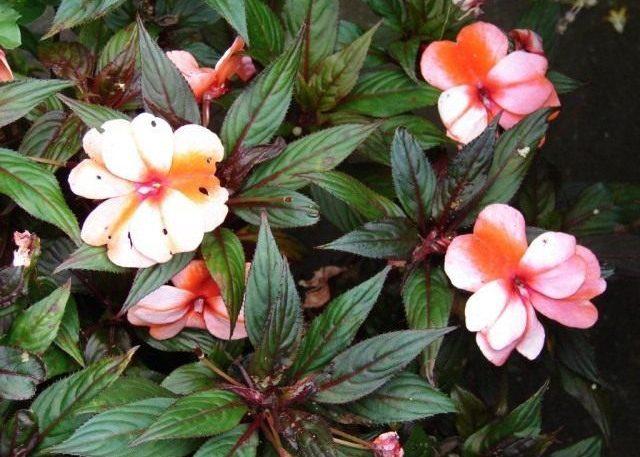
New guinea
It is more often grown as an indoor perennial. The plant is tall but compact. It grows up to 30-45 centimeters in height. It is characterized by abundant and long flowering. Requires long daylight hours and high temperatures. It has large double flowers, mostly pinkish and scarlet.
Terry
Indoor culture with dark green shiny leaves and large double flowers. Impatiens blooms almost all year round. Flower petals can be pink, scarlet, snow-white, solid or variegated.
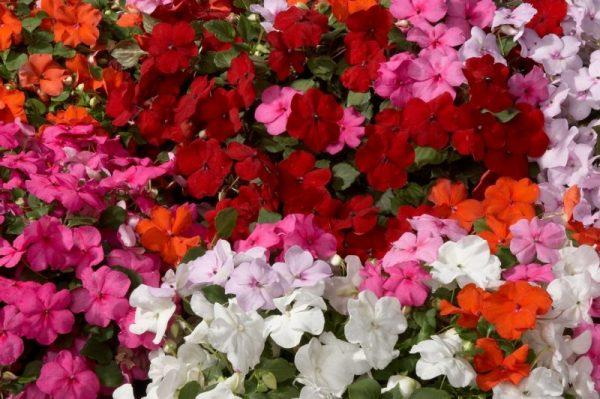
Growing from seeds at home
You can grow a touchy seed yourself. It is recommended to buy seeds of hybrid plants in specialized stores. These plants are grown in small containers or single containers (plastic cups). For the garden, seeds of annuals are purchased, and for indoor cultivation - perennials.
Sowing
The seeds are preliminarily placed for swelling in warm water for a day. In March, they are sown in containers filled with substrate. The soil should be loosened, without lumps, well moistened. The seeds are sown, and lightly sprinkled with sand on top and irrigated with water. The container is covered with glass or foil.
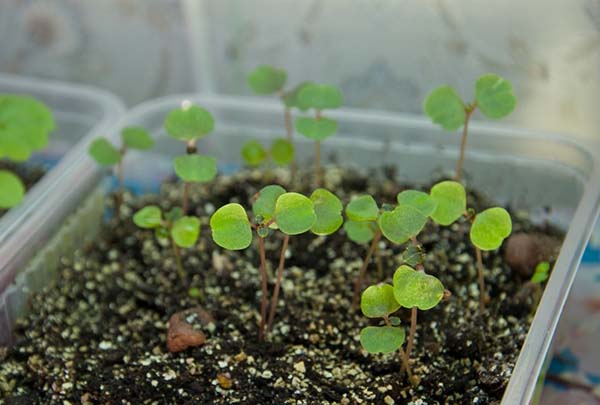
Illumination
Seeds germinate after 1-2 weeks. Seedlings need to provide ten hour daylight hours. It is advisable to put containers with growing seedlings on the windowsill, and in the dark - to illuminate with lamps.
Priming
For Vanka Wet, a neutral and light soil mixture is suitable. Planting substrate can be bought ready-made or made yourself. The land for sowing seeds should consist of garden or leaf land, sand and peat. Seedlings of Impatiens do not like organics. The substrate is pre-disinfected with boiling water or a solution of potassium permanganate. A little perlite is added to the ground, a drainage layer is laid on the bottom of the box.
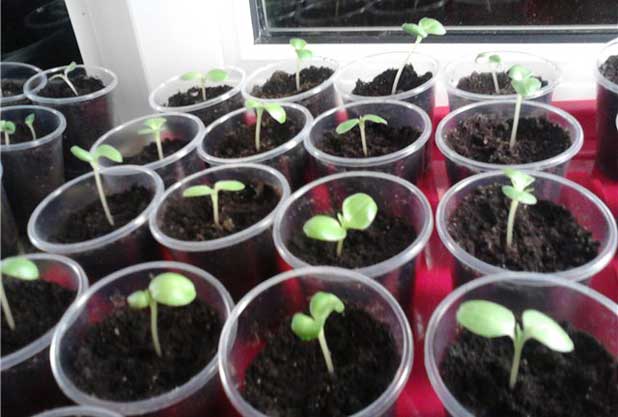
Picking
Developing seedlings should be irrigated regularly with water. When 2-3 true leaves appear on the seedling, you need to dive. The plants are transplanted individually into peat or plastic cups and the roots are pinched.
Top dressing
At the very beginning, the plants are irrigated with Fitosporin solution, for the prevention of possible diseases. After transplanting into separate containers, the seedlings are fed with complex fertilizer for indoor flowers (begonias, geraniums, violets) or Fertika-Lux, Kemira-Lux fertilizer.

Content temperature
Seedlings should be kept in a warm room. The optimum temperature for development is 20 degrees Celsius. Balsam does not tolerate a temperature drop of up to 10 degrees. Before transferring the seedlings to the flower bed, they must be hardened. For example, regularly ventilate the room where the plant is located. You can take out pots with seedlings in May every day outside for several hours.
Conditions for growing a flower in the garden
Balsam is a thermophilic culture. Seeds, seedlings or ready-made purchased plants are planted outside at the end of May. Most often, gardeners grow balsam in seedlings. Seedlings grown in room conditions are transplanted to a flower bed at the end of May, when the threat of night frosts has passed, and the air warms up to 20 degrees Celsius. At a temperature of 5-10 degrees above zero, the plant may die.
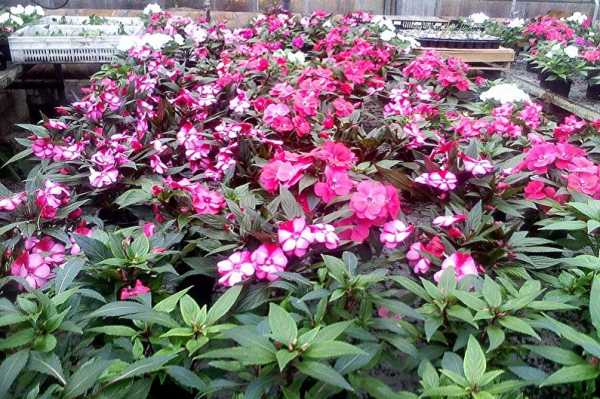
First you need to prepare the soil for the flower bed. Balsam grows on neutral, fertile, loose, light soil. The soil must pass water well. On clay, acidic and heavy soil, balsam will quickly wither. For Vanka Wet, a soil consisting of garden, leafy, turfy soil mixed with peat, sand and humus in equal amounts is suitable.
Weeding
A flower bed must be constantly looked after.Remove grown weeds, loosen the soil, break up the soil crust. You can mulch the ground with sawdust. Weeds will not be able to break through from under the layer of mulch.
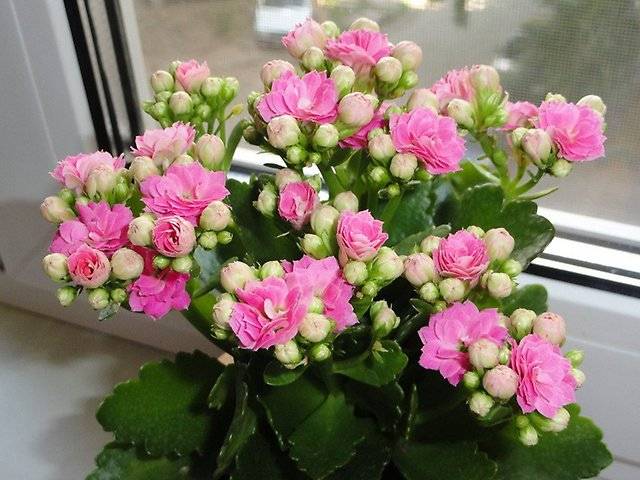
Top dressing
Impatient is fed every 2 weeks. At the very beginning of development, nitrogen fertilizers are applied to the soil. During the flowering period, the soil is fed with potassium and phosphorus additives. For balsam, complex fertilizers for flowering plants or feeding for geraniums are suitable. For 1 square meter of land, you need to dilute 30 grams of fertilizer in 10 liters of water.
Watering
Roly Wet needs to be watered regularly. Do not allow the soil to dry out. With insufficient watering, the balsam withers quickly. However, it is also not recommended to flood a flower bed. In highly moist soil, the plant will begin to rot.
It is advisable to spray the leaves of Impatiens with cold water. Thus, you can protect bushes from spider mites and aphids.
Illumination
Vanka Wet prefers open, sunny places. It is desirable for the plant to be in partial shade in the midday heat. Balsam blooms beautifully under trees with a sparse crown or on the northwest (northeast) side of the house. Balsam has very fragile stems that break in a strong gust of wind. The plant is best planted in places protected from drafts and wind.
Features of indoor growing in a pot
Balsam feels great on the windowsill. True, in summer, in the heat, the plant must be covered from the scorching sun rays. In the autumn-winter period of Impatient it is necessary to provide additional lighting, because this perennial has almost no dormant period.
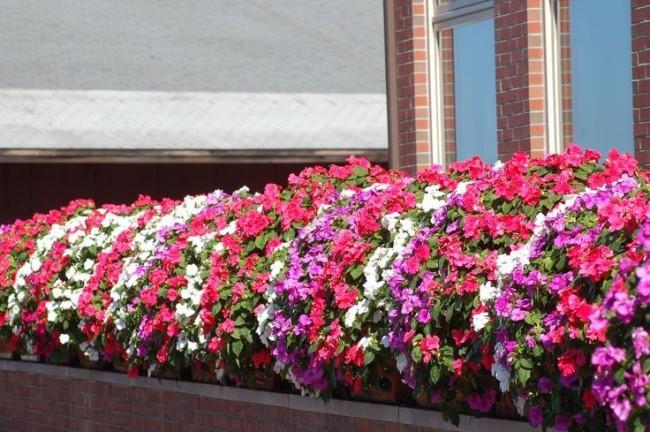
In summer, the temperature of the content can be 20-25 degrees, in winter - 15-18 degrees of heat. The balsam pot is first chosen close, with a drainage hole at the bottom. Vanka Wet will bloom after the roots completely fill the space inside the pot. As the root system grows, the touchy one is transplanted into a more spacious container.
Soil and watering
For indoor Impatiens, a light, slightly acidic or neutral soil is suitable. The composition of the soil should include garden or leaf (sod) soil, sand, peat, perlite. At the bottom of the pot, drainage from expanded clay or stones is laid.
The plant is watered regularly, the leaves are watered every other day. In summer, it is advisable to take flower pots to the balcony.
If Vanka Mokrom becomes too hot, he may wither or discard flowers and buds. In summer, the plants are irrigated in the evening; in the sun, the leaves can become covered with burn marks due to the remaining droplets of water. Once a month, together with water, complex fertilizers for flowering plants are applied to the ground.
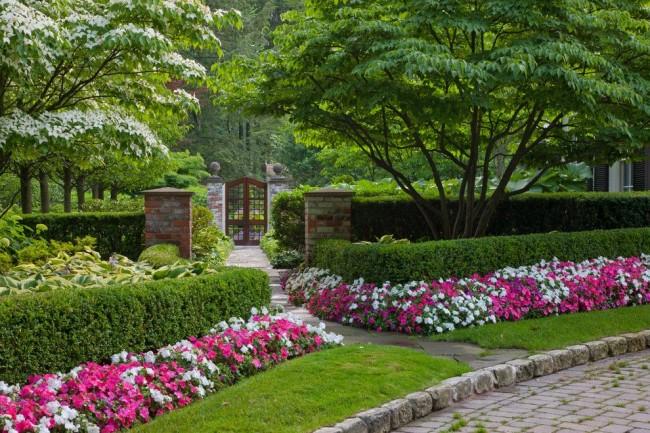
Diseases and pests
Vanka Wet can get sick if he is not properly looked after, rarely watered, or, conversely, the ground is heavily flooded with water. The plant's immunity weakens with a lack of nutrients in the soil. Balsam, with improper care, affects a fungal infection. It is in the soil, and then through the roots and stems it passes to the leaves and flowers. The leaves are covered with yellow, brown, grayish spots, turn yellow and dry out.
Spraying with Fitosporin saves from fungal infection.
The most dangerous pest of indoor balsam is the spider mite. This tiny soft-bodied red insect winds a cobweb on the leaves of a plant and feeds on its juice. Spraying with cold water and an insecticide solution (Akarin, Agravertin, Kleschevit) is saved from the tick. Yellowed or yellow-spotted leaves affected by the tick must be removed.
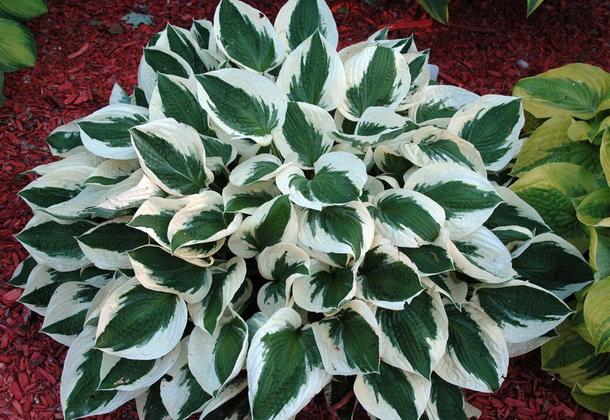
Popular species and varieties
Most of the varieties are obtained on the basis of garden balsam, Waller or Hawker, which became the progenitor of the famous New Guinea hybrids. Plants differ in stem shape, height, structure and color of flowers.
Hawker's Impatiens hawkeri
The plant that gave birth to New Guinea hybrids. Leaves - oblong, pointed at the end, shiny.Flowers - large, simple, with a spur, various shades, with a white core. The height of the balsam is 25-60 centimeters. Stems are erect, long, fleshy.
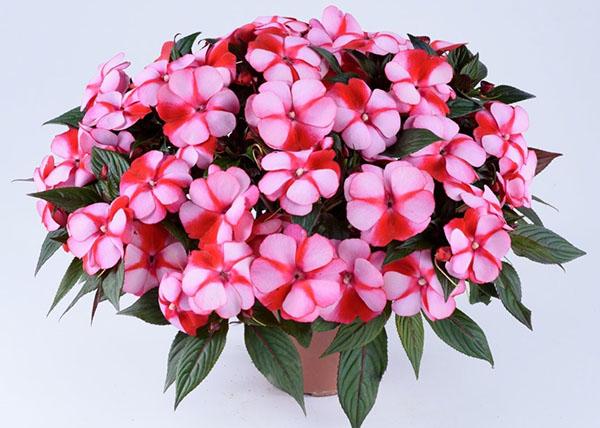
Large-flowered Impatiens hookeriana or Impatiens grandis
The plant is native to Sri Lanka. It has long, fleshy stems. The leaves are shiny, as if covered with wax, green. Flowers - large, orchid-like, white, pinkish, scarlet.
Creeping Impatiens repine
The plant is used in hanging pots, it has creeping, rising up, very fragile reddish shoots that break off easily during strong winds. Leaves are small, shiny, bronze-green. The flowers are bright, yellow, large, with a spur.
Impatiens walleriana or Impatiens Waller
A perennial plant often grown as a garden annual. Waller's balsam is a low, strongly branched spherical bush. Flowers can be simple or double, of various colors, located at the top of lush green foliage.
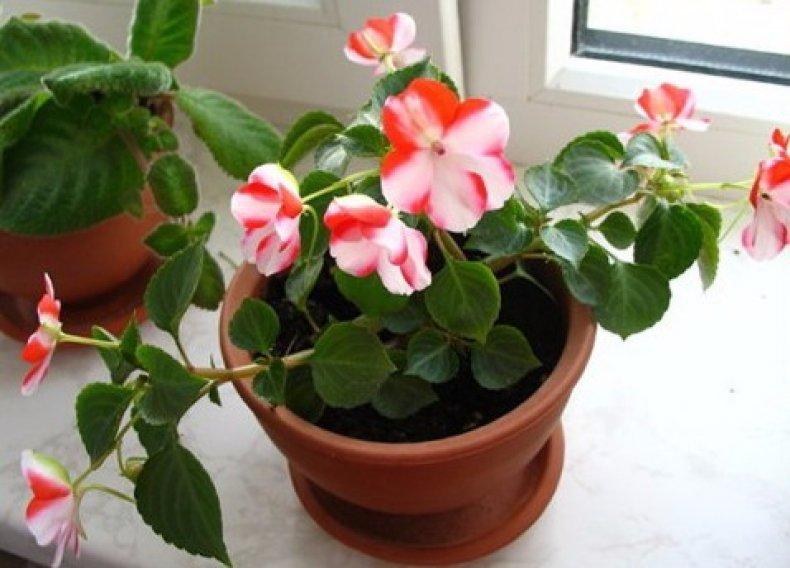
Forest
An annual, herbaceous, poisonous plant. It grows one meter in height. Stem - erect, covered with leaves, can branch. The flowers are like a shoe. They can be pale pink or lilac.
Planting and care in the open field
Balsam can be planted in front of the windows of your house or in a city flower bed. Seeds for seedlings are preliminarily sown in March. The grown seedlings are transferred to the street at the end of May or at the very beginning of June. Before transplanting, the seedlings are accustomed to outdoor conditions.
The optimum temperature for planting outdoors is 18-20 degrees Celsius.
Landing features
Roly Wet in the garden is grown as an annual plant. Loves non-acidic, light, well-drained soil. It is better to plant balsam in a bright and well protected place from the wind. Before planting, the soil must be fertilized with humus, add a little sand or peat, loosen and moisten well. Seedlings are planted in shallow pits, on the bottom of which a little sand is poured. The distance to the neighboring plant should be 30 centimeters.
Watering and feeding
Balsam will bloom profusely if watered regularly. It is undesirable to fill the soil with water. In swampy ground, Impatiens will begin to rot. Adult plants are watered and irrigated with water every other day. However, in rainy weather, watering is stopped.

During watering, young plants are additionally fed with nitrogen substances. During the flowering period, the soil is fertilized with potassium and phosphorus. You can use complex commercial fertilizers for flowering plants. The touchy is fed once a month.
Reproduction
The touch-me-not is propagated by seeds or cuttings. Seeds are sown for seedlings in March. At the end of May, the seedlings are transferred to the street. Cuttings from growing balsams can be rooted all summer.
Seeds
Roly Wet can be propagated by seeds. Usually seeds are sown not earlier than March, when daylight hours will become longer. Prepare the substrate before sowing. The soil mixture can be purchased or prepared independently from garden, leafy soil, with the addition of sand, peat. Seeds are sown on moist soil and covered with foil. Shoots appear after 1-2 weeks.
The optimum temperature for germination is 20-25 degrees Celsius.
Cuttings
Balsam can be propagated using cuttings, that is, cuttings in spring, summer and even autumn. The broken off upper branches must be put into water, and after a week they will sprout. Rooting can be done in wet sand or vermiculite. Then cuttings with roots are transplanted into peat-garden soil.
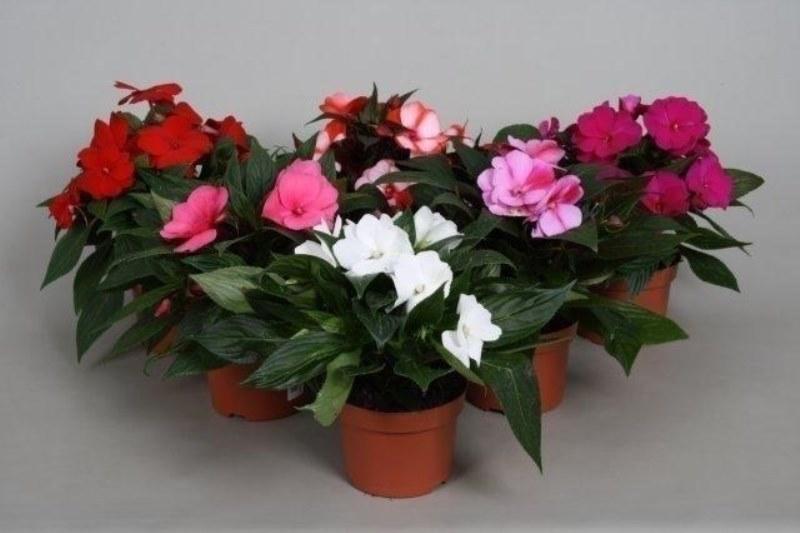
How to get seeds right
Balsam blooms all summer, and in autumn juicy fruits appear in the form of a box with seeds. Harvesting seeds is not easy. After all, the boxes explode from a light touch, and the seeds scatter to the sides.You can cover the boxes with a bag or bag and carefully collect the seeds in it.
They practice collecting the fruits that are not yet fully ripe, which ripen in a dry room for several weeks. In the fall, after the fruits ripen, the annual plant is removed from the flower bed, and the next year new seeds are sown. The seed remains germinating for 3-5 years.
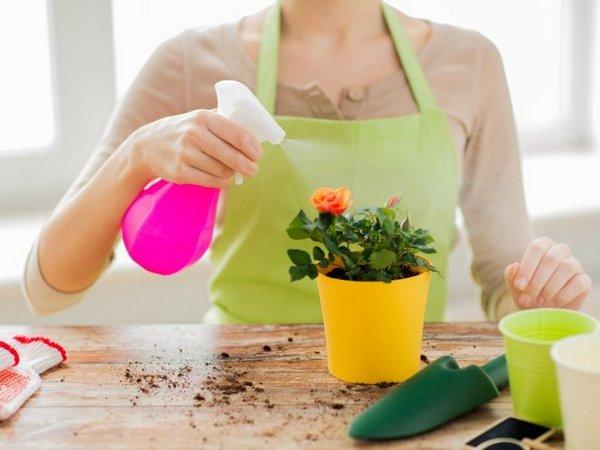
Seedling growing
Balsam is a thermophilic plant with a long growing season. When the temperature drops to 5 degrees Celsius, it may die. To get a flowering bush in June, in March you need to sow seeds for seedlings.
Disinfection
Before sowing seeds, you need to prepare the soil. You can buy ready-made peat-based soil mixture. You can prepare the substrate yourself. To do this, you need to take in equal proportions garden, sod or leafy soil, peat, sand. It is desirable to disinfect the substrate with boiling water, a solution of potassium permanganate or Fitosporin.
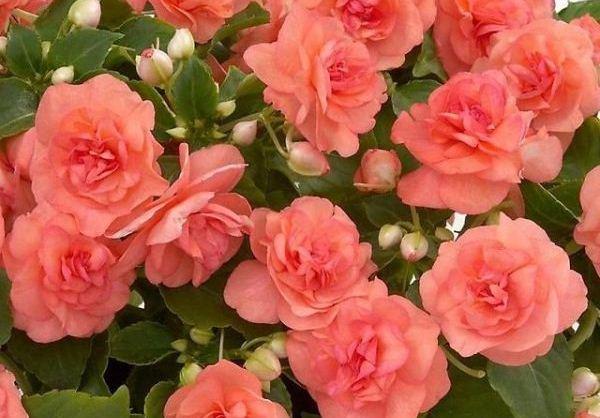
Landing scheme
Balsam seeds are sown in boxes filled with substrate, at a distance of 1 centimeter from each other. Previously, the earth is loosened and moistened. From above the seeds are lightly sprinkled with sand and sprinkled with water. When the seedlings germinate, they will need to be dived and planted in separate containers.
Film or glass
Seeds sown in the ground are irrigated with water and covered with transparent glass or foil. Every day the glass is raised, the ground is lightly irrigated with water. When shoots appear, the film is removed.
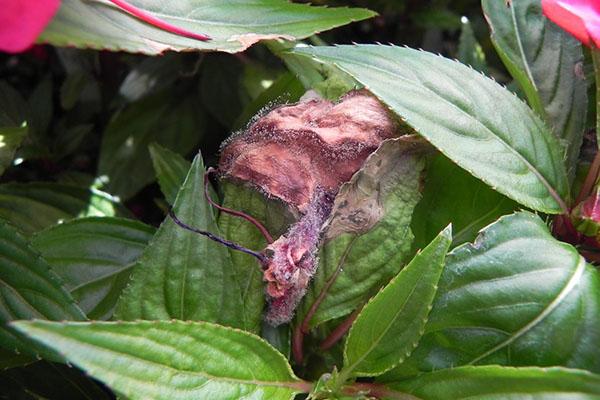
Landing and aftercare
At the end of May, the grown seedlings are transferred to the street. Plants are carefully planted in the dug holes together with the earthy clod. In the summer, Touchy must be regularly watered, weeds removed from the flower bed and fed with complex fertilizers once a month.
Care features
Vanka Wet is a non-capricious plant. It does not require any special care, only a minimum of attention. The main thing is to ensure Impatient regular watering and timely fertilization.
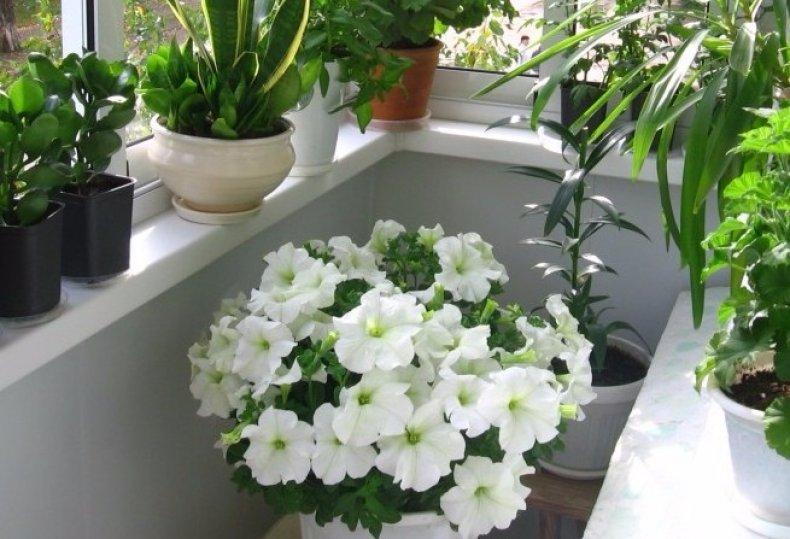
Watering
You need to water Touchyou regularly, make sure that the earth does not dry out. Balsam instantly reacts to lack of moisture - its leaves curl, flowers droop. With insufficient watering, the plant can shed flowers and buds.
Spraying
It is advisable to irrigate balsam every other day with cold water. This procedure will save the plant from the spider mite and saturate the Touch with moisture.

Pinching and trimming
It is necessary not only to look after balsam, but also to pinch it correctly. When the plant grows a little, it is advisable to shorten its top. The balsam will no longer stretch upwards, but will begin to form side shoots. The plant will take the shape of a spherical, compact bush. True, for this you need to constantly cut off the stems that are too elongated.
Top dressing
For abundant flowering, Impatient needs to be fed 1-2 times a month with complex fertilizers for flowering plants.
It should be remembered that with an excess of nitrogen supplements, the plant will receive lush greenery, and flowering may not occur.
Hardening
Usually touchy seedlings sown on seedlings are hardened before being transplanted to the street. The room where the seedlings grow is regularly ventilated. In May, in warm weather, boxes with seedlings are taken out into the sunlight for several hours.
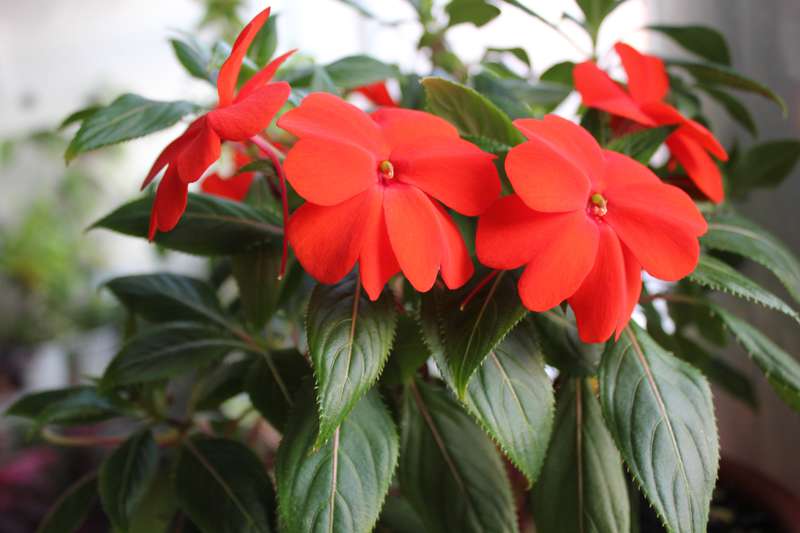
Wintering
In autumn, the yellowed and fading garden balsam is cut off, the roots are dug up and removed from the flower bed. Save the bush in winter will not work. With the onset of frost, he will quickly die. A new plant is sown the next season.
Pruning
Balsam should be pruned in spring or early summer so that the plant takes on the shape of a compact, low bush. Usually at the stem, 30-40 centimeters long, pinch the top. Balsamin begins to actively form lateral shoots.
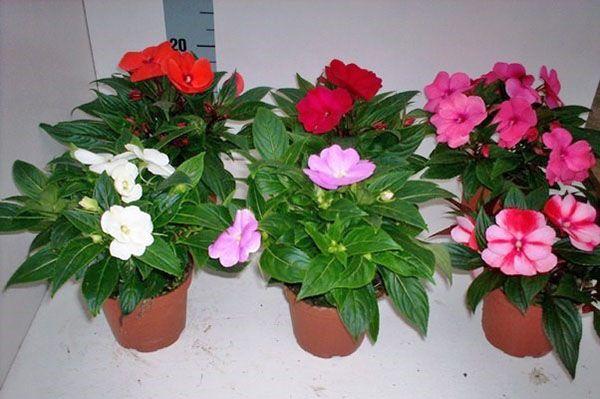
Diseases and pests
In rainy and cool weather, balsam growing in a flower bed can get sick.The plant is often affected by fungal infections, due to which its roots rot, the stems darken, the leaves become covered with brown and gray spots, and subsequently wither. Preventive spraying with fungicides (Fundazol) saves from fungi.
Spider mite
The touchy is often attacked by insects, for example, aphids, whiteflies, thrips, ticks. Most often, balsam suffers from spider mites. It is a small reddish insect that weaves webs and sucks sap from leaves.
Spraying with cold water, soapy water or insecticide treatment (Spark) is saved from ticks.
Viral mosaic
Hard to reach is affected not only by fungi, but also by viruses. The diseased leaves become covered with yellow spots, and then dry up and wither. Protecting balsam from the viral mosaic is not easy. The best preventive measure is proper care and adequate mineral supplementation.
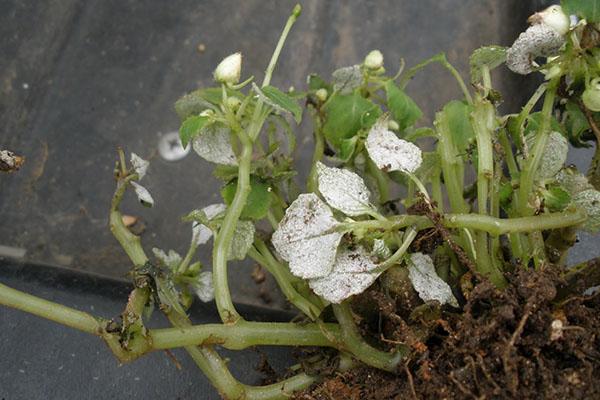
Bronze of leaves
With improper care of balsam, lack of potassium, after strong liming of acidic soils, the leaves can become covered with small dots of dead tissue, acquire a bronze color, become wrinkled, twist downward.
Leaf bronzing can be caused by a virus. As a preventive measure, the soil is disinfected with potassium permanganate before planting balsam, a sufficient amount of potassium and phosphorus is introduced.
Ring mosaic
Light round spots appear on the affected leaves of the plant. The disease is caused by a virus. Its vital activity can lead to the death of the plant. Correct care, timely application of fertilizing, removal of weeds, spraying of the soil and plants with a weak solution of potassium permanganate saves from the virus.
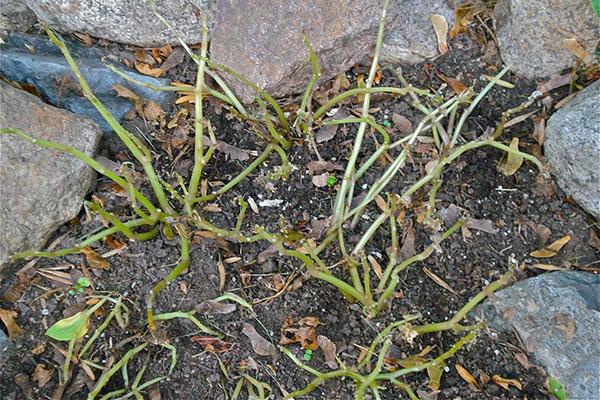
Flower arrangements
Vanka Wet is an irreplaceable plant often used in flower arrangements. Balsam goes well with begonia, boxwood, violets, bells. Hard to get used to decorate city flower beds, alpine slides, create mixboxers.
Balsam is planted in pots, hanging pots, decorating loggias and balconies with flowers.
Reviews
Irina Anatolyevna, 49 years old
“I took the cuttings of Vanka Mokroi from friends and put them in the water. A week later, the roots appeared. The cuttings quickly took root in a pot with ordinary garden soil. Now it is a short bush with bright red flowers. I put the pot with Vanka Wet on the street for the summer. "



